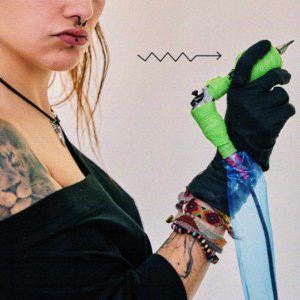
BOOK YOUR APPOINTMENT NOW!
- Shop 62, Brisa Residency Complex, Naika vaddo, Bardez, Calangute Candolim Sinquerim Rd, Calangute, Goa - 403516
- info@sandytattoo.com
- +91 95526 66999
The Comprehensive Guide to Getting a Custom Tattoo Design from Start to Finish

INTRODUCTION
Tattoos are a form of identity, art; an open book of life story or passion or belief system on the skin. Having your tattoo done is a great experience, as it lets you come up with a design that will be special and close to your heart. This article will guide you through the process of getting a custom tattoo design from the time you decide that you want a tattoo to the time when it is finally etched on your skin.
Step 1: Conceptualize Your Idea
Understand Your Motivation
It is very important to identify the purpose of getting a tattoo before proceeding to the next step of designing. Are you celebrating an occasion, celebrating your individuality, or just being an art lover? Understanding your goal will help in determining the style to be implemented in the design.
Gather Inspiration
Begin keeping mementos that you are coming across, drawings, or anything that appeals to you. This could be other tattoos, art, the many beauties of nature, quotes, or even symbols. The last opinion with images can be found on Pinterest, Instagram, and in magazines with tattoos.
Decide on Placement
The locations where the tattoos are placed will determine the design. Think about how you want it to stand out, if at all, how it complements the other tattoos you may have, where the body part that is being inked falls on the body.
Step 2: Research Tattoo Artists
Look for Specialists
The popular types include realism, traditional, watercolor, tribal, or geometric among many other forms of body art. Select an artist whose art matches your theme or subject matter. Check their work on web pages, and social networks, or visit the tattoo conventions.
Check Reviews and Recommendations
Research on the internet, and take a word from friends, acquaintances, or other users. A good artist with recommendations of good feedback will build up your confidence in that particular artist to deliver your desired design.
Schedule Consultations
After that, you should make a shortlist of several potential artists and schedule consultations with them. This will let you talk to the artist and see the hygiene level of the studio as well as the personality and attitude of the artist that will paint your body.
Step 3: Collaborate on the Design
Share Your Ideas
When consulting, make sure to present all the materials assembled and describe your idea in depth. Share your preferences and the things you don’t like, as well as additional features that you’d like to be used. The more information you give to the artist the better they will be able to paint what you want.
Trust the Artist’s Expertise
Yes, it is okay to communicate your point across but let the artist do his/her best in giving the tattoo. They can offer advice on such aspects as design, dimensions, location of the picture, and colors that would be most appropriate for the skin.
Review and Revise
After the discussion, the artist will make a rough sketch of the design. Read it thoroughly, and come back with commentary. Do not be afraid to request changes if something is not quite right. This is teamwork, and it is highly desirable that you are fully satisfied with the chosen design.
Step 4: Preparing for the Tattoo Session
Plan Your Appointment
Once you have an agreed design, fix the date for the tattooing. Since it is a tattoo, it may take several sittings depending on the size and details of the design.
Follow Pre-Tattoo Care Instructions
Before you get a tattoo, you will be given guidelines on how to prepare for the tattoo. This often involves drinking water, maintaining adequate sleep, and avoiding products such as alcohol and blood-thinning drugs. Ensure that you take your breakfast or other meals before the appointment so that you do not get tired.
Step 5: The Tattooing Process
The Tattoo Session
Be punctual, well-rested, and eager to present yourself at the studio. The artist will take the stencil of your design place it on your skin and draw corrections if needed. After being satisfied with the position, the tattooing process itself will start.
Manage Discomfort
The process causes some discomfort but the level can differ depending on the location and individual pain threshold. Take deep breaths and do not be shy in requesting rest if you feel they are struggling. Gossiping with the artist or taking a friend along to distract your mind can be very helpful.
Step 6: Post-Tattoo Care
Follow Aftercare Instructions
Aftercare is very important when it comes to healing and the overall durability of the tattoo. The artist will give the client care instructions which may include washing the tattoo gently, applying a topical ointment, and not exposing the tattoo to direct sunlight or immersing in water.
Monitor the Healing Process
The recovery period of the tattoo is normally within a few weeks. It is also common for the tattoo to scab and shed as this is just part of the process. Do not scratch the wounds, as this could lead to infection and hinder the healing process.
Step 7: Enjoy Your Custom Tattoo
Show Off Your Art
After the tattoo has healed, you can proudly display your custom artwork Tattoos are a lifetime investment therefore should take good care of your skin to keep the tattoo looking great.
Touch-Ups
However, as the years go by, the skin tattoos may pale. Some artists may give free or affordable touch-up sessions, so inquire from your artist on this topic. To keep the skin around it looking fresh and that the colors remain vivid the tattoo needs touch-ups.
FAQ
1: How much does a custom tattoo cost?
They differ concerning size, complexity, and the artist’s experience; the hourly rate ranges from $50 to several hundred dollars
2: How long does it take to get a custom tattoo?
It ranges from an hour, depending on the design’s size and complexity, to individuality that may take one or several sessions
3: Can I bring my design to the tattoo artist?
Yes, most artists will not have a problem with your designs and will build on them until it is fine-tuned to meet the specific requirement.
4: Is it safe to get a tattoo?
Yes, this procedure can be done safely provided one visits a qualified studio that observes high hygiene standards as well as having sterilized equipment.
5: How do I know if I’m allergic to tattoo ink?
Discuss with your artist about the patch test that involves putting a little ink on the skin to see how the skin will react.
Conclusion
Having your tattoo designed is one of the main things that can help add value to one’s body art. In this way, you can guarantee the procedure to run without complications and finally obtain a piece of art that will last a lifetime. Remember as always, always communicate with your tattoo artist, prepare well, and be very careful after the process. Have fun as you make your way to putting your story on your skin!
is proudly powered by WordPress
